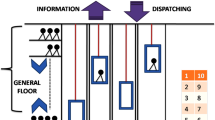Abstract
A multi-car elevator system is an elevator system that has more than one car installed in each elevator shaft. This system enables us to improve the transportation capability without increasing the occupied floor space. The primary purpose of this study is to consider the group control problem of operating cars efficiently without collision nor reversal in a multi-car elevator system, based on a detailed and realistic model where floor stoppage time of cars cannot be known in advance. In the context of elevator systems, reversal means that a car travels in the direction opposite to the desired direction of on-board passengers, which is prohibited because it makes passengers uncomfortable. We first propose an optimization-based collision and reversal avoidance method to operate cars in the same shaft. Next, we construct simple methods to allocate calls to individual cars under immediate and delayed guidance policies. Under the immediate guidance policy a call is allocated to a car immediately after it is registered, while under the delayed guidance policy the allocation may be changed until it is actually served. The effectiveness of the proposed group control method is examined by computer simulation.


















Similar content being viewed by others
References
Fujimura T, Ueno S, Kiyotake A, Miwa H (2009) Algorithm for controlling multi-car elevator systems based on procedures estimating efficiency of passenger transport and call assignability. IEICE Trans Fundam E92–A:2790–2793
Gale J (2003) ThyssenKrupp’s TWIN lift system. Part one: the introduction. Elev World 51(7):51–53
Hiller B, Klug T, Tuchscherer A (2014) An exact reoptimization algorithm for the scheduling of elevator groups. Flex Serv Manuf J 26(4):585–608
Hirasawa K et al. (2008) A double-deck elevator group supervisory control system using genetic network programming. IEEE Trans Syst Man Cybern Part C 38(4):535–550
Ikeda K, Suzuki H, Markon S, Kita H (2007a) Designing traffic-sensitive controllers for multi-car elevators through evolutionary multi-objective optimization. Lecture Notes Comput Sci 4403:673–686
Ikeda K, Suzuki H, Markon S, Kita H (2007) Traffic-sensitive controllers for multi-car elevators; design, multi-objective optimization and analysis. In: Proceedings of the SICE annual conference 2007, 2655–2662
Kuroda Y, Nakata M (2008) An algorithm to minimize average service completion time for the group controller of multi-car elevator systems. IEICE Trans Fundam E91–A:3215–3218
Li Z-W, Wu N-Q, Zhou M-C (2012) Deadlock control of automated manufacturing systems based on Petri nets—a literature review. IEEE Trans Syst Man Cybern Part C Appl Rev 42:437–462
Markon S, Suzuki H, Ikeda K, Kita H (2007) Direct control of multi-car elevators with real-time GA. In: Proceedings of the 11th international conference on intelligent engineering systems (INES 2007), 191–194
Miyamoto T, Yamaguchi S (2008) MceSim: a multi-car elevator simulator. IEICE Trans Fundam E91–A:3207–3214
Onat A et al. (2010) Design and implementation of a linear motor for multicar elevators. IEEE Trans Mechatron 15:685–693
Qiu L, Hsu W-J, Huang S-Y, Wang H (2002) Scheduling and routing algorithms for AGVs: a survey. Int J Prod Res 40:745–760
Schröder J (1990) Advanced dispatching—destination hall calls + instant car-to-call assignments: M10. Elev World 3:40–46
Sorsa J, Siikonen M-L, Ehtamo H (2003) Optimal control of double-deck elevator group using genetic algorithm. Int Trans Oper Res 10:103–114
Strakosch GA (ed) (1998) The vertical transportation handbook, 3rd edn. Wiley, NewYork
Suzuki H et al. (2004) Simulation-based optimization of multi-car elevator controllers using a genetic algorithm (in Japanese). Trans Soc Instrum Control Eng 40(4):466–473
Takahashi S et al. (2003) Simulation-based optimization of a controller for multi-car elevators using a genetic algorithm for noisy fitness function. Proc 2003 Congr Evolut Comput 3:1582–1587
Tanaka S, Uraguchi Y, Araki M (2005) Dynamic optimization of the operation of single-car elevator systems with destination hall call registration: part I. Formulation and simulations. Eur J Oper Res 167:550–573
Valdivielso A, Miyamoto T (2011a) Multicar-elevator group control algorithm for interference prevention and optimal call allocation. IEEE Trans Syst Man Cybern Part A 41:311–322
Valdivielso A, Miyamoto T (2011b) Option-based Monte Carlo algorithm with conditioned updating to learn conflict-free task allocation in transport applications. IEICE Trans Fundam E94–A:2810–2820
Valdivielso AC, Miyamoto T (2012) Performance evaluation of an option-based learning algorithm in multi-car elevator systems. IEICE Trans Fundam E95–A:835–839
Valdivielso AC, Miyamoto T (2012) Knowledge reuse method to improve the learning of interference-preventive allocation policies in multi-car elevators. IEICE Trans Fundam E95–A:990–995
Yu L, Mabu S, Hirasawa K (2011) Multicar elevator group supervisory control system using genetic network programming. IEEJ Trans Electr Electron Eng 6(Suppl. 1):S65–S73
Acknowledgments
This work is partially supported by Grant-in-Aid for Scientific Research (C) 23560483, from the Japan Society for the Promotion of Science (JSPS).
Author information
Authors and Affiliations
Corresponding author
Rights and permissions
About this article
Cite this article
Tanaka, S., Hoshino, D. & Watanabe, M. Group control of multi-car elevator systems without accurate information of floor stoppage time. Flex Serv Manuf J 28, 461–494 (2016). https://doi.org/10.1007/s10696-016-9238-6
Published:
Issue Date:
DOI: https://doi.org/10.1007/s10696-016-9238-6




